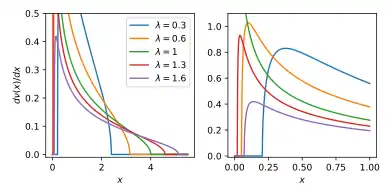Marchenko–Pastur distribution
In the mathematical theory of random matrices, the Marchenko–Pastur distribution, or Marchenko–Pastur law, describes the asymptotic behavior of singular values of large rectangular random matrices. The theorem is named after Soviet mathematicians Vladimir Marchenko and Leonid Pastur who proved this result in 1967.

If denotes a random matrix whose entries are independent identically distributed random variables with mean 0 and variance , let
and let be the eigenvalues of (viewed as random variables). Finally, consider the random measure
counting the number of eigenvalues in the subset included in .
Theorem. Assume that so that the ratio . Then (in weak* topology in distribution), where
and
with
The Marchenko–Pastur law also arises as the free Poisson law in free probability theory, having rate and jump size .
Cumulative distribution function
Using the same notation, cumulative distribution function reads
where and .
Moments
For each , its -th moment is
Some transforms of this law
The Cauchy transform (which is the negative of the Stieltjes transformation) is given by
Voiculescu's -transform is given by
and the -transform by
Application to correlation matrices
For the special case of correlation matrices, we know that and . This bounds the probability mass over the interval defined by
Since this distribution describes the spectrum of random matrices with mean 0, the eigenvalues of correlation matrices that fall inside of the aforementioned interval could be considered spurious or noise. For instance, obtaining a correlation matrix of 10 stock returns calculated over a 252 trading days period would render . Thus, out of 10 eigenvalues of said correlation matrix, only the values higher than 1.43 would be considered significantly different from random.
References
- Götze, F.; Tikhomirov, A. (2004). "Rate of convergence in probability to the Marchenko–Pastur law". Bernoulli. 10 (3): 503–548. doi:10.3150/bj/1089206408.
- Marchenko, V. A.; Pastur, L. A. (1967). "Распределение собственных значений в некоторых ансамблях случайных матриц" [Distribution of eigenvalues for some sets of random matrices]. Mat. Sb. N.S. (in Russian). 72 (114:4): 507–536. Bibcode:1967SbMat...1..457M. doi:10.1070/SM1967v001n04ABEH001994. Link to free-access pdf of Russian version
- Nica, A.; Speicher, R. (2006). Lectures on the Combinatorics of Free probability theory. Cambridge Univ. Press. pp. 204, 368. ISBN 0-521-85852-6. Link to free download Another free access site
- Zhang, W.; Abreu, G.; Inamori, M.; Sanada, Y. (2011). "Spectrum sensing algorithms via finite random matrices". IEEE Transactions on Communications. 60 (1): 164–175. doi:10.1109/TCOMM.2011.112311.100721. S2CID 206642535.
- Epps, Brenden; Krivitzky, Eric M. (2019). "Singular value decomposition of noisy data: mode corruption". Experiments in Fluids. 60 (8): 1–30. Bibcode:2019ExFl...60..121E. doi:10.1007/s00348-019-2761-y. S2CID 198436243.